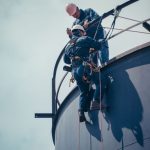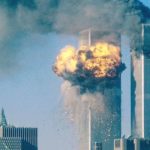
ABSTRACT:
All western democracies are now acutely aware of the apocalyptic consequences of a well-orchestrated attack on high-profile government facilities and other related targets. Many of these buildings are historical, ornate, listed and constructed using traditional techniques. Many of the modern retrofitted reinforcement techniques used to protect these structures against terrorist attacks are unsightly, intrusive or inappropriate. However, security specialists are well aware that while there might be little that can be done to defend a building against an aircraft attack, much can be done to defeat the more traditional car bomb and bullet. The methods available to the structural engineer to strengthen existing structures and provide resistance to the effects of a blast attacks are discussed in this paper.
1. INTRODUCTION:
The design of civilian or commercial buildings to withstand the effects of a terrorist blast is unlike the design of military installations or the design of embassy buildings. The objectives of the “Structural Engineering Guidelines” for the Design of New Embassy Buildings are to prevent heavy damage to components and structural collapse. Adherence to the provisions of the guidelines will minimize injuries and loss of life and facilitate the evacuation and rescue of survivors. The blast-protection objective of any commercial or public building must be similar to those of embassy structures, that is, to prevent structural collapse, to save lives, and to evacuate victims.
Architectural and structural features play a significant role in determining how the building will respond to the blast loading. These features can include adjacent or underground parking, atriums, transfer girders, slab configurations, and structural-frame systems. The keep-out distance is vital in the design of blast resistant structures since it is the key parameter that determines the blast overpressures that load the building and its structural elements. The degree of fenestration is another key parameter as it determines the pressures that enter the structure. The smaller the door and window openings the Embassies and military structures occupy secure sites with substantial keep-out distances better protected the occupants are within the structure. Following these key parameters,
2. EXPLOSION-MAJOR OF ALL THE TERRORIST ACTIVITIES
The probability that any single building will sustain damage from accidental or deliberate explosion is very low, but the cost for those who are unprepared is very high.
2.1 EXPECTED TERRORIST BLASTS ON STRUCTURES.
• External car bomb
• Internal car bomb
• Internal package
• Suicidal car bombs
2.2 MAJOR CAUSES OF LIFE LOSS AFTER THE BLAST.
• Flying debris
• Broken glass
• Smoke and fire
• Blocked glass
• Power loss
• Communications breakdown
• Progressive collapse of structure
3. GOALS OF BLAST RESISTANT DESIGN
The goals of blast-resistant design are to:
• Reduce the severity of injury
• Facilitate rescue
• Expedite repair
• Accelerate the speed of return to full operations.
4. BASIC REQUIREMENTS TO RESIST BLAST LOADS
To resist blast loads,
– The first requirement is to determine the threat. The major threat is caused by terrorist bombings. The threat for a conventional bomb is defined by two equally important elements, the bomb size, or charge weight, and the standoff distance – the minimum guaranteed distance between the blast source and the target
– Another requirement is to keep the bomb as far away as possible, by maximizing the keepout distance. No matter what size the bomb, the damage will be less severe the further the target is from the source.
– Structural hardening should actually be the last resort in protecting a structure; detection and prevention must remain the first line of defense. As terrorist attacks range from the small letter bomb to the gigantic truck bomb as experienced in Oklahoma City, the mechanics of a conventional explosion and their effects on a target must be addressed.
4.1. MECHANICS OF A CONVENTIONAL EXPLOSION
With the detonation of a mass of TNT at or near the ground surface, the peak blast pressures resulting from this hemispherical explosion decay as a function of the distance from the source as the ever-expanding shock front dissipates with range. The incident peak pressures are amplified by a reflection factor as the shock wave encounters an object or structure in its path. Except for specific focusing of high intensity shock waves at near 45° incidence, these reflection factors are typically greatest for normal incidence (a surface adjacent and perpendicular to the source) and diminish with the angle of obliquity or angular position relative to the source. Reflection factors depend on the intensity of the shock wave, and for large explosives at normal incidence these reflection factors may enhance the incident pressures by as much as an order of magnitude Charges situated extremely close to a target structure impose a highly impulsive, high intensity pressure load over a localized region of the structure; charges situated further away produce a lower-intensity, longer-duration uniform pressure distribution over the entire structure. In short by purely geometrical relations, the larger the standoff, the more uniform the pressure distribution over the target. Eventually, the entire structure is engulfed in the shock wave, with reflection and diffraction effects creating focusing and shadow zones in a complex pattern around the structure. Following the initial blast wave, the structure is subjected to a negative pressure, suction phase and eventually to the quasi-static blast wind. During this phase, the weakened structure may be subjected to impact by debris that may cause additional damage


